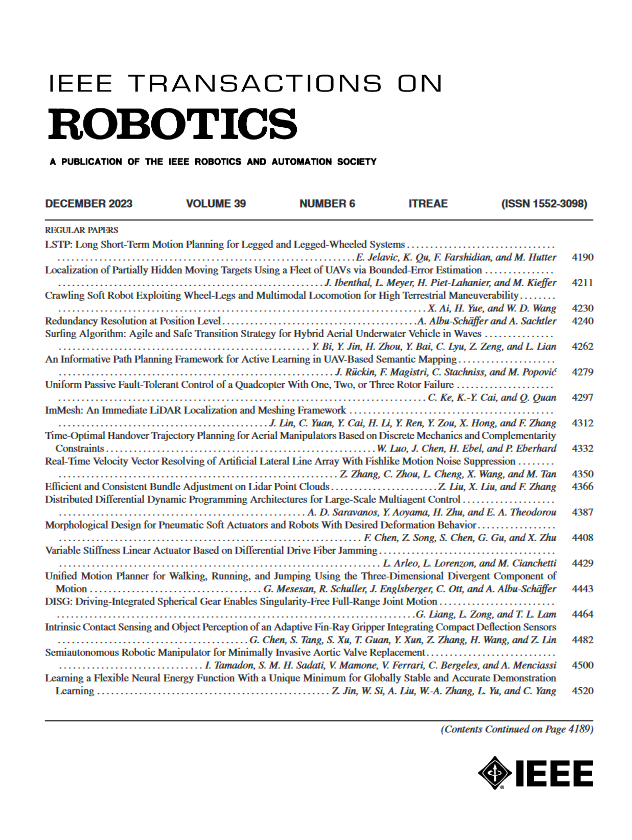带运动环系统递归正激动力学的传播观点
IF 10.5
1区 计算机科学
Q1 ROBOTICS
引用次数: 0
摘要
我们重新审视约束嵌入的概念,作为在刚体系统动力学计算中处理运动环约束的一种手段。具体来说,我们考虑了现代机器人系统中常见驱动子机构(例如,减速电机,差动驱动和四杆机构)中出现的局部环约束。作为对先前约束嵌入工作的补充,我们提出了一种分析,将单个刚体之间的关节模型和运动/力子空间的传统概念推广到受环约束的刚体组之间的广义关节模型和运动/力子空间。然后,我们利用这些广义概念推导了使用多柄铰接体的约束嵌入递归前向动力学算法。我们通过展示它们如何导致基于约束嵌入的逆动力学递归算法来证明广义联合概念的广泛适用性。最后,我们在c++中对前向动态算法和最先进的稀疏性利用算法进行了基准测试。我们的替代推导旨在使约束嵌入方法更容易被更广泛的机器人社区所接受,而基准研究澄清了约束嵌入与稀疏性利用方法的相对优势和局限性。事实上,我们的基准测试验证了约束嵌入在涉及局部运动循环的情况下优于非递归替代方案。本文章由计算机程序翻译,如有差异,请以英文原文为准。
A Propagation Perspective on Recursive Forward Dynamics for Systems With Kinematic Loops
We revisit the concept of constraint embedding as a means for dealing with kinematic loop constraints during dynamics computations for rigid-body systems. Specifically, we consider the local loop constraints emerging from common actuation submechanisms in modern robotics systems (e.g., geared motors, differential drives, and four-bar mechanisms). As a complementary perspective to prior work on constraint embedding, we present an analysis that generalizes the traditional concepts of joint models and motion/force subspaces between individual rigid bodies to generalized joint models and motion/force subspaces between groups of rigid bodies subject to loop constraints. We then use these generalized concepts to derive the constraint-embedded recursive forward dynamics algorithm using multihandle articulated bodies. We demonstrate the broad applicability of the generalized joint concepts by showing how they also lead to the constraint-embedding-based recursive algorithm for inverse dynamics. Lastly, we benchmark our open-source implementation in C++ for the forward dynamics algorithm against state-of-the-art, sparsity-exploiting algorithms. Our alternative derivation is intended to make the constraint-embedding methodology more accessible to the broader robotics community, while the benchmarking study clarifies the relative strengths and limitations of constraint embedding versus sparsity-exploiting methods. Indeed, our benchmarking validates that constraint embedding outperforms the nonrecursive alternative in cases involving local kinematic loops.
求助全文
通过发布文献求助,成功后即可免费获取论文全文。
去求助
来源期刊

IEEE Transactions on Robotics
工程技术-机器人学
CiteScore
14.90
自引率
5.10%
发文量
259
审稿时长
6.0 months
期刊介绍:
The IEEE Transactions on Robotics (T-RO) is dedicated to publishing fundamental papers covering all facets of robotics, drawing on interdisciplinary approaches from computer science, control systems, electrical engineering, mathematics, mechanical engineering, and beyond. From industrial applications to service and personal assistants, surgical operations to space, underwater, and remote exploration, robots and intelligent machines play pivotal roles across various domains, including entertainment, safety, search and rescue, military applications, agriculture, and intelligent vehicles.
Special emphasis is placed on intelligent machines and systems designed for unstructured environments, where a significant portion of the environment remains unknown and beyond direct sensing or control.
 求助内容:
求助内容: 应助结果提醒方式:
应助结果提醒方式:


